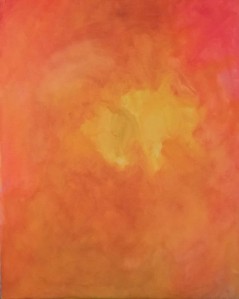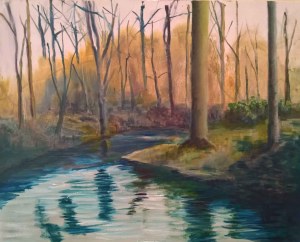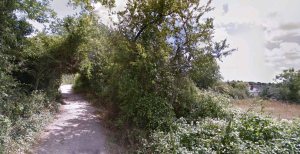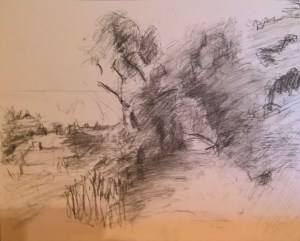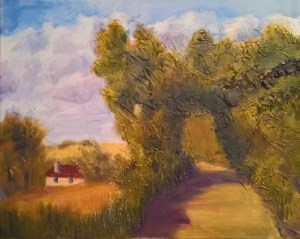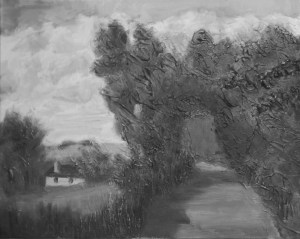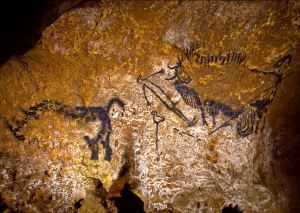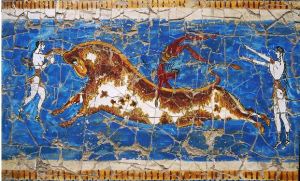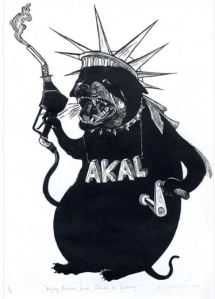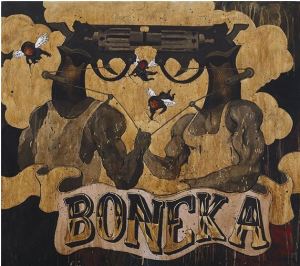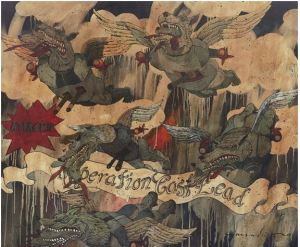Still life with restaurant 1
Last November I had a delightful lunch in a lovely restaurant in Paris near the Marmottan Monet Museum called La Rotunde de la Muette.
As the people on the next table left, I did a quick sketch of the still life they left behind before the waiters came to tidy up. It was a scene that stayed with me, one of those cheer me up memories for a rainy day, a sight that looked for all the world like an impressionist painting.

Figure 1 sketch ink on A6 cartridge
I recalled my memory when I was back in London especially when I saw this;

Figure 2 A Bar at the Folies Bergere, Edouard Manet
and then later this;

Figure 3 The Dining Room, Vernon Pierre Bonnard
And of course this;

Figure 4 Christ in the House with Martha and Mary, Diego Velasquez
In each case I was fascinated with the importance of the still life in the overall composition. I thought about it for a long time and then I painted this.

Figure 5 Still life with Restaurant Oils on 50 x 40 canvas
What is it?
It is a figurative oil painting on canvas in landscape format 50cm x 40cm. The background is washed subtle blues that give a suggestion of distance, there is little detail in the mid ground, preserving the aerial perspective whilst the foreground is fully detailed drawing the eye to caress the still life forms at the expense of the deliberately peripheral ground.
What was the process?
The initial inspiration was the small sketch done on location, further inspiration came from the works at figures 2, 3 and 4, the composition of the final piece was based on the Golden Section and was drawn onto the canvas using dilute blue oil paint The whole of the canvas was washed in using oil paint diluted with Gamasol and then thicker layers of paint were added to the foreground and midground to bring them forward.
What is the context?
It sits in the long tradition of European easel painting and is particularly inspired by the images at figures 2,3 and 4. Still life has been an important genre in painting since early times and it flourished in the Renaissance as an excuse for the artist to display his talent and techniques, Caravaggio in the Baroque period added the most marvellous still lives to his religious paintings and you can see the importance of the still life in Velasquez’s painting at figure 4 . In 17th century Holland the still life reached its epoch in the Vanitas paintings, as religious paintings were no longer required painters turned to depictions of the wealthy object of their merchant patrons, however the history genre paintings still required a amount of still life objects to add realism to the overall paintings, thus the still life genre retained its importance. With Manet the supportive still life flourished, you only have to look at the discarded luncheon in Le Dejuener sur l’herbe or indeed the still life on the bar at figure 2 to realise how important to the composition as a whole the still life group is. Whilst Bonnard is famous as a colourist the importance of the still life objects in his paintings is patently obvious as can be seen in Figure 3.
The painting is an investigation of space, in the hole in the wall fashion, using aerial and single point mathematical perspective to create depth on a two dimensional canvas.
It would have been quite easy to develop the midground and the background of the painting to take the total focus off the still life group and make it subservient to the busy restaurant, but the still life group was what caught my eye in the first place, it speaks as an absence of people, almost in a vanitas way, fore-telling that people are transient and there will always be empty bottles and glasses and bills in the restaurant long after the current patrons are dead and gone. It is an extortion, if you like, to live well, because one day there will be another to take your place after you have left. The empty table and the still life contrasts with the ghostly conviviality of the diners in the midground.
What would you change if you had to do it again?
This is not a difficult question to answer, because I did do it again, although in a different way and this question is answered further on in this post.
Still life red and green
Having painted still life in a restaurant I thought a little more about still life went to Sainsbury’s and set up a still life and did a few sketches and drawings.

Figure 6 Compositional sketch for Still life red and green, graphite on A4 cartridge paper.
Then I painted this;

Figure 7 Still life with red and green, oils on 40 x 50 canvas board
What is it?
It is a figurative oil painting on canvas board in portrait format 40cm x 50cm. The background is washed subtle blues that give a suggestion of distance, there is no midground, the foreground is fully detailed emphasising the form of the still life objects and their relationship in three dimensional space.
What was the process?
The inspiration was to investigate space in relation to the forms, the composition of the final piece was based on the Golden Section and was drawn onto the canvas using dilute blue oil paint. The whole of the canvas was washed in using oil paint diluted with Gamasol and then thicker layers of paint were added to model the forms. Once the composition was established the still life set up was removed and the objects were handled to establish their volume and feel.
What is the context?
It sits in the long tradition of European easel painting. Still life has been a genre since Egyptian art and after its zenith in seventeenth century Holland it was thoroughly investigated by Chardin in the eighteenth century and again by Cezanne in the late nineteenth century.
This painting is an honest investigation of the volumes and forms of the objects and the light falling on them. It has avoided the chiaroscuro of Chardin preferring the lightness of Cezanne
What would you change if you had to do it again?
I would soften the hard edges within and as contours of the fruit and introduce darker darks to the fruit to give more modelling.
Still life with restaurant 2
Still life with restaurant 1 had been hanging on the studio wall for a couple of weeks and I began to think it would look better if the still life was a bigger focus of the picture plane and to further subjugate the restaurant. So I painted this;

Figure 8 Still life with restaurant 2, oils on 50 x 40 cm canvas
What is it?
It is a figurative oil painting on canvas in landscape format 50 x 40 cm. The background is washed subtle blues and greys that give a suggestion of distance, the midground is suggestive of a crowded restaurant, the foreground is a fully detailed still life
What was the process?
The inspiration was Still life with restaurant 1 the composition of the final piece was again based on the Golden section and was drawn onto the canvas using dilute blue oil paint. The whole of the canvas was washed in using oil paint diluted with Gamasol and then thicker layers of paint were added to model the forms. Once the composition was established the still life set up was removed and the objects were handled to establish their volume and feel.
What is the context?
It sits in the long tradition of European easel painting and has a more modern post impressionist feel than the first version. The paint handling in modelling the forms is much softer that either of the two earlier of the still life’s and it is all together less harsh in the choice of colouring producing a more harmonious gentle effect. The still life dominates the picture plane whilst still giving a nod to the restaurant setting.
The figure on the right reminds me of an out of focus Vincent and is probably an unconscious reaction from my trip to Auvers sur Oise last November.
What would you change if you had to do it again?
Seriously not a lot it may benefit from developing the background to give the whole thing a flatter less perspectival feel bur the background is quite flat and mirror like already so I am not sure if this would help. I did do it again though in a much flatter and different style.
Still life with restaurant 3
There was something about the composition of the second version that got under my skin that meant something deeper to me. I investigated this composition further in my sketchbook because I was a little unsure how to take the series on.
I produced this;

Figure 9 Sketch ink on A4 cartridge
This followed;

Figure 10 Sketch ink and marker pens on A4 cartridge
And finally this;

Figure 11 Sketch ink on A4 cartridge
Eventually I had the courage to take up the brushes again and I painted this.
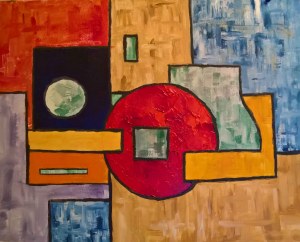
Figure 11 Still Life with Restaurant 3, oil on canvas board 50 x 40 cm
What is it?
It is a non figurative oil painting on canvas board in landscape format 50 x 40 cm. There is an overall flatness to the piece that is disrupted and denied by the overlapping forms and the positioning of the colours giving a shallow picture space.
What was the process?
The inspiration was Still Life with Restaurant 2 the composition of the final piece was again based on the Golden Section it was painted alla prima using brushes and a palette knife.
What is the context?
It sits in the long tradition of European easel painting but is somehow no longer a traditional easel painting. It has a contemporary feel to it and it is only from the title and the sketches that you can realise that it is a struggle with the form of objects in a similar way that Picasso and Braque struggled with form in their cubist experiments but with a markedly different result.
The use of texture in painting is a modern innovation and this painting exploits the use of texture to the full in the relatively shallow picture space.
The small blue rectangle at the base of the picture is almost a monochrome version of the original picture, this was unconscious and I only noticed this after the painting was dry.
What would you change if you had to do it again?
Absolutely nothing, and as well as that, this was the most enjoyable painting of the series to paint there were no forms to achieve and the painting just flowed where it wanted to go with only a slight touch of the rudder by me.
